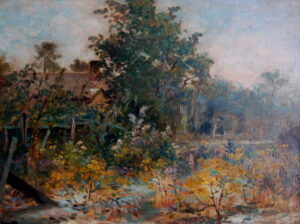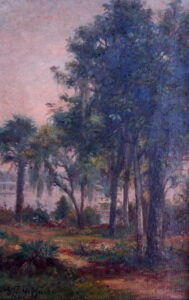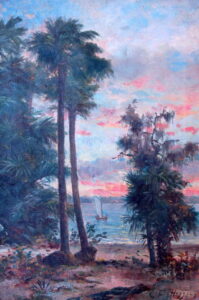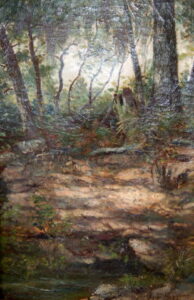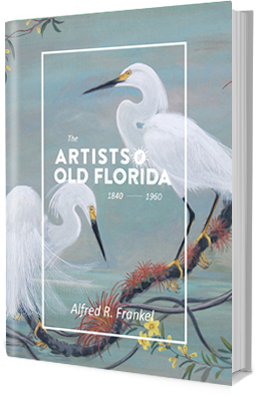George Franklin Higgins, Florida Retreat, oil on canvas, 12 by 16 inches, sighed lower right, G. F. Higgins
Boston’s George Franklin Higgins was one of the first New England artists to visit Florida. Higgins’ Florida paintings, considering they were done over one-hundred years ago, can be found with surprising frequency here in Tampa Bay, but it was only recently that I found out why.
I first learned of Higgins work in Florida back about 1990, when I bought a copy of Art and Artists of the South, The Robert P. Coggins Collection, by Bruce W. Chambers. Chambers notes, “Very little is known about Higgins except that he exhibited at the Boston Atheneum in 1859 and 1861, and remained active in Boston until 1884. A number of his Florida scenes have come to light recently, which, if they date to the 1870’s, are among the earliest views of the Florida pine woods and swamplands.”
George Franklin Higgins, oil on canvas, 18 by 12 inches, signed lower left G. F. Higgins.
It wasn’t long after that I wandered into an antique shop in Dania, Florida and discovered one of his Florida scenes on sale. I bought it for $900. Any lover of antiques knows about and loves the Brimfield Flee Market just west of Boston. Years ago, I flew up for the Spring market, telling my friends I was off to find the great Florida antique. And I did! It was a sunny, brisk Spring morning as I wandering down a front isle near the famous big red barn, when some twenty feet away, almost hidden under a fold out table, was a painting with what appeared to be a palm tree, I walked over, picked it up and found Higgins, Florida Retreat. I purchased it for $250.
The first exhibit of Florida art by Florida artists was organized by the Students’ Art Club of Tampa, May 1,1922 at the Tampa Public Library. The Students’ Art Club later became the Tampa Museum of Art. The exhibition catalogue notes a painting by G. W. Higgins, number 37, A Florida River. One day I was working in the research room at the Lakeland Public Library when I found, quietly hanging nearby, a Higgins landscape of what looked like a St. Johns River scene. The same painting? I like to think so.
Now I wanted to know more but newspaper archives were not then available online. If I wanted to learn more I would have to fly to Boston. My wife at the time worked for Delta Airlines so, able to fly standby to Boston, at little cost, I spend days in the microfilm files of the Boston Public Library and the New England Historical Society looking for Higgins. I even wandered the streets near Higgins home in Summerville, a Boston suburb, hoping to find something of his time there. Here is what I learned.
Higgins exhibited with many of New England’s most famous artists, but today in Boston and here in Florida, his work has been nearly forgotten. Born in Massachusetts in July of 1834, the son of John and Mary A. Higgins. His first appearance as a professional artist was at the 33rd Annual Exhibition of the Boston Athenaeum on Beacon Street in Boston in April 1859. Higgins painting, Boston Common, from the Public Library was for sale. Exhibiting with Higgins were icons of early Nineteenth Century American art, including Washington Allston, William Morris Hunt, Albert Bierstadt, and Fitz Hugh Lane.
Higgins appears in the Federal Census of 1860 as a twenty-five-year-old landscape painter. Exhibiting at the Boston Athenaeum in 1861, his painting, On the Androscoggin was hung with work by Washington Allston, J.G. Brown, William Trost Richards, and William H. Beard.
The following year, in May 1862, Higgins is found in the Boston Artists Sale Catalogue of Original Paintings by Boston Artists, at the rooms of Messrs. Williams and Everett, at 234 Washington St.
Leonard and Co. Auctioneers, Bromfield Street, offered paintings by Higgins including, Old Farmhouse, Shelburne; Haying Time, North Conway; Glimpse of the Mystic River-Somerville; Early Summer Landscape; On the Androscoggin-Bethel, Me.; Road through the Woods; View at Nahant; Ascutney Mountain-Windsor-Vermont; On the Androscoggin-Shelburne- N. H.; White Mountains from Shelburne- N.H.
Other artists in the auction include Benjamin Champney and Frank Shapleigh. Higgins continued to exhibit at Elliot, Blakeslee and Noyes, Leonard’s, Williams and Everett, for the next forty years. Boston City Directories indicate a studio at his home in Summerville and at the Boston Studio Building. An active member of the Boston Art Club, he exhibited there from 1873 to 1891.
There are numerous reviews of Higgins work in Boston newspapers. The Boston Transcript, March 17, 1874, “G. F. Higgins has sold at a handsome figure his fine New England farm scene, exhibited at the gallery of the Studio Building before it was closed some months ago. It goes to Chicago, where it will be a creditable example of Boston art. Mr. Higgins has a genuine feeling for nature, and a loving and faithful pencil to placer his subtle harmonies on canvas. His proper rank in art is alongside our best artists-such as Hill, George L. Brown, Longfellow, Keith, and J. J. Enneking, and he is gradually working his way to recognition in his true sphere.”
The Transcript, March 24, 1874 devoted a long column to Higgins exhibit, now moved to Leonard’s. “The fine art scale of G. F. Higgins to take place at Leonard’s next Friday, offers to the public a collection such as few of our art lovers, who are not familiar with is improving qualities, will be prepared for. While embracing nothing sensational, nothing outré, nothing to call for an ebullition of enthusiasm to pass away as suddenly as a Southwestern tornado, not one bearing his name but will stand scrutiny, and not only be as favorite a subject after a year on the walls, but will improve by age, as choice scenes in nature do to the lover of her occult mysteries. There is sympathy and a union with nature that is finely manifest in the touch of his pencil, and freshness and crispness that is never attained by tedious studio work, but rather by studying nature at first hand. One of our best-known picture dealers said only last week, that Mr. Higgins would occupy an undisputed front rank if he were not so modest and diffident as to suffer himself to be crowded into a secondary position by those whose interests might thus be enhanced, and if he were not so sensitive as to hesitate about using the same means for self-advancement that so many others unscrupulously do. Mr. Higgins has nearly forty of the hundred and twenty-six in the collection, and there is not a badly composed, carelessly painted one among them. His care and conscientiousness are very marked characteristics, while at the same time there is never a tendency visible to approach the finical.”
In the Spring of 1875 Higgins exhibited some twenty painting at Williams and Everett. The Boston Weekly Transcript, March 23, reviewed the exhibit, “Home Talent in Art. A little rivalry in art is not a bad thing, if we may judge from the fact, probably undisputed, that the exhibition I the Studio Building gallery has had the effect to spur the artists who paint after a different school to show themselves at their best, as they do in the exhibition that opened yesterday at Williams & Everett’s. Few of the artists represented have ever shown a succession of better pictures, and there are fewer bad pictures than are usually found at such a sale. Messrs. Higgins and Benjamin Champneys have about twenty pictures each, and other artists, to the number of thirty-five, are represented by one or more apiece, the whole number reaching nearly 200 subjects, making a creditable show in quantity as well as quality. The pictures as a class show care and attention, and an evident desire on the part of the artists to please their customers as well as work in the interest of art in a general sense. The subjects by G. F. Higgins are marked by an excellence higher than he has before attained. He displays more strength, while not losing at all in the quality of color or simplicity of touch.”
Higgins exhibited with the Boston Art Club in 1882, 1883, but with only one or two paintings in each exhibit. The Boston City Directory of 1890 notes Higgins with a home at Atlantic and a studio at 110 Tremont, room 26.
The first evidence of Higgins work in Florida appears in a Boston Art Club exhibit of 1891 with his oil painting, On Haw Creek, Near Crescent City, Florida. In 1893 the Boston Art Guide and Artist’s Directory lists Higgins at 26 Studio Building with thirty-seven other Boston artists.
George Franklin Higgins, oil on canvas, 19 by 13 inches. Sighed lower right, G. F. Higgins.
The first record of Higgins in Florida is found in The St. Augustine Tatler, March 7, 1896, “Mr. George F. Higgins, Boston artist, arrived at the Hotel Punta Gorda, Punta Gorda, Fla., on Monday night and will make an extended sojourn. A painting of the quaint dwelling of ‘The Oldest Punta Gorda Inhabitant” executed during the week.”
Higgins is last found in the Boston Directory in 1899 with a 1 Somerset address. The United States Federal Census of 1900 gives another glimpse of the artist. His parents are gone, his wife, Anni W. Higgins, dead, and Higgins living as a border in the home of Samuel and Mary Merrill and their twenty-six-year-old daughter, Kittie. Higgins is described as “65-year-old white male, widower, ARTIST.”
Higgins moved to Tampa in 1903. The Tampa Tribune, Thursday August 25, 1904, “Mr. G. F. Higgins, of Boston, who has been well known in Tampa for the past two years, has several beautiful oil paintings on exhibition at the Tampa Bay (Hotel), They represent Florida landscape scenery mostly, and are very attractive.” A year later August 18, 1906, the Tribune carried Higgins obituary. “Death of Aged Artist Formerly with Tampa Bay. G. Frank Higgins of Boston, a noted landscape artist, formerly of the Tampa Bay Hotel, died Friday morning of tuberculosis at his home on North Nebraska Avenue, after an illness of long duration. The funeral of Mr. Higgins will take place at 9 am today from the residence. Burial will be made in Woodlawn Cemetery. Mr. Higgins has made and had sold many beautiful paintings of Florida scenery; such having been his especial hobby.”
George Franklin Higgins, oil on canvas, 18 by 12 inches. Signed lower right G. F. Higgins.
In 2005 the Tampa city’s Parks and Recreation Department commissioned a ground penetrating radar survey for a section of Woodlawn known as Potters Field, which was used as burial grounds for the city’s poor. The survey showed nearly 600 suspected graves in what is now an empty field running along North Boulevard…. A developer has been asking the city council for permission to build homes on this part of the cemetery. I will try to find his grave and report back.
Well, that’s George Franklin Higgins, a Bostonian who dedicated his life to art, whose final resting place may be a Potter’s Field in Tampa. It was an honor for me to introduce you. Someday when you are out antiquing perhaps you will meet him again. Born: July, 1834. Membership: Boston Art Club. Died: August 17, 1906, Tampa, Florida.

